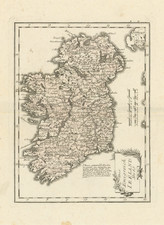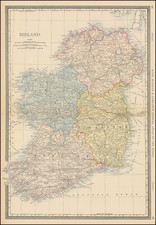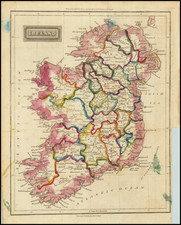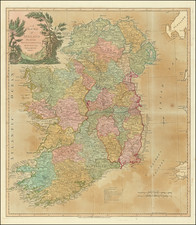Parte settentrionale dell'Irlanda Descritta and Parte Meridionale dell'Irlanda Descritta, by Vincenzo Maria Coronelli and published in Venice in 1690, stand as remarkable two-sheet mapping of Ireland. Encompassing the entirety of the island, the maps showcase Coronelli's distinctive stylistic embellishments, from the elaborate title cartouche exhibiting hunting and fishing iconography, to the proudly displayed coat of arms of Ireland, graced with a harp.
The late 17th century witnessed a fervent exploration of geography and the resultant flourishing of map-making in Europe. In this epoch, Coronelli's maps of Ireland serve as a testament to the advancement of cartography and the growing European interest in the topographies of neighboring lands. The details present on this map bear a strong resemblance to those on Coronelli's renowned globe of 1688, integrating his expertise and echoing a wider European movement to understand and represent the world with increasing precision.
A central aspect of Coronelli's map that captures attention is the careful engraving and the opulence of visual motifs. The grandeur of the cartouche designs, especially the representation of the coat of arms with its resonant harp symbol, positions the map as not merely an instrument of geography but also an artistic artefact. This intertwining of cartography and artistry is a defining feature of Coronelli's oeuvre.
Vincenzo Maria Coronelli's pivotal stature in the annals of cartography is further underscored by his vast contributions to the field. A Venetian scholar, Minorite Friar, and the founder of the inaugural geographical society, the Academia Cosmografica degli Argonauti, Coronelli's prolific output spanned terrestrial and celestial globes, myriad maps, and numerous cartographic publications. His appointment as the Cosmographer of the Republic of Venice and the creation of the Marly Globes for Louis XIV elucidate the reverence and acclaim his work garnered during his time.
Vincenzo Maria Coronelli (1650-1718) was one of the most influential Italian mapmakers and was known especially for his globes and atlases. The son of a tailor, Vincenzo was apprenticed to a xylographer (a wood block engraver) at a young age. At fifteen he became a novice in a Franciscan monastery. At sixteen he published his first book, the first of 140 publications he would write in his lifetime. The order recognized his intellectual ability and saw him educated in Venice and Rome. He earned a doctorate in theology, but also studied astronomy. By the late 1670s, he was working on geography and was commissioned to create a set of globes for the Duke of Parma. These globes were five feet in diameter. The Parma globes led to Coronelli being named theologian to the Duke and receiving a bigger commission, this one from Louis XIV of France. Coronelli moved to Paris for two years to construct the King’s huge globes, which are 12.5 feet in diameter and weigh 2 tons.
The globes for the French King led to a craze for Coronelli’s work and he traveled Europe making globes for the ultra-elite. By 1705, he had returned to Venice. There, he founded the first geographical society, the Accademia Cosmografica degli Argonauti and was named Cosmographer of the Republic of Venice. He died in 1718.











![Johnson's Ireland [with] Johnson's Scotland](https://storage.googleapis.com/raremaps/img/small/78184.jpg)

![[ British Isles ] (Tabula. I. Europae)](https://storage.googleapis.com/raremaps/img/small/72090.jpg)
